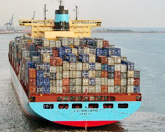A Maersk Line service between Asia and Europe is undergoing significant rotation and capacity adjustments, according to research by ComPair Data.
Maersk has dropped two ships from its AE7 loop -- taking it from 12 to 10 ships -- while it also will begin rotating smaller vessels into the service. Until recently, the service had been the repository for Maersk’s largest vessels -- the Emma Maersk and her sister ships, with capacity of roughly 15,500 TEUs.
However, the line has begun rotating in much smaller 8,950-TEUs ships and sped up the service, reducing total roundtrip sailing time from 84 to 70 days. The smaller vessels will result in a roughly 32 percent drop in capacity offered by the service, ComPair Data estimates.
In addition, Maersk has changed the rotation of the service, dropping calls in Hong Kong, Algeciras and Malaga, and calling Ningbo before Shanghai. The revised rotation is now Ningbo, Shanghai, Xiamen, Yantian, Tanjung Pelepas, Tangiers, Felixstowe, Bremerhaven, Rotterdam, Tangiers and Ningbo. The service has operated with 10 vessels with an average capacity of roughly 13,000 TEUs, but that average will drop as the smaller ships are rotated in.
The service has been a standalone Maersk loop since June 2010, when former partner CMA CGM left to jointly operate a separate Asia/Europe loop with Maersk. Maersk operates nine other Asia/Europe services. The changes could well be a sign that Maersk sees too much capacity on the Asia/Europe lane, where rates have sunk precipitously in the last year.
American Shipper













